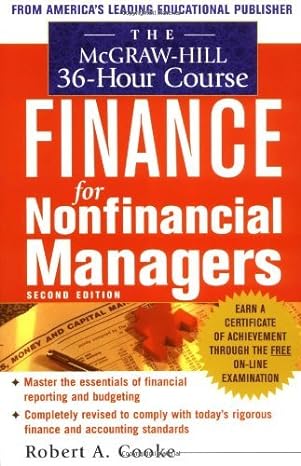Question
The following Income Statement comes from the fiscal year 2020 of DPC college (all amounts in $). Revenues from tuition fees 440,000 Minus Cost of
The following Income Statement comes from the fiscal year 2020 of DPC college (all amounts in $). Revenues from tuition fees 440,000 Minus Cost of services provided (70,116) Gross profit 369,884 Minus Operating expenses (303,600) Profit before taxes 66,284 So far, DPC has been renting its facilities (building, equipment etc.) for $60,000 annually. This expense is included in Operating expenses above. DPCs owner could acquire now, i.e. 01/01/2021, all equipment (instead of renting it) for $600,000. Further assume the following: i. Useful life of building and equipment = 50 years; Salvage Value = 100000; Straight-line depreciation ii. Corporate tax rate = 30% iii. Net working capital = 20% of next years revenues iv. Revenues are expected to increase 3% annually for the next 5 years 12 v. Costs and expenses except for depreciation and interest (if any) are expected to increase by 2% annually for the next 5 years vi. DPC would apply a zero-payout dividend policy the next 5 years, i.e. retain all its earnings (if any) vii. The acquisition would be financed as follows: a. $500,000 with a new bond with 10 years maturity and 5% annual coupon rate. Similar bonds are discounted at 6% annually b. The rest with new common stocks. DPCs unlevered beta has been estimated 0.5. Floatation costs are 1% of stock price. Market annual return is 8%. Risk-free rate is 2%. viii. The investment could be sold as it is for $700,000 after 5 years. As it is means that the buyer would pay $700,000 to DPCs owner and receive all common stocks. Therefore, the $700,000 amount represents the net proceeds from the sale of investment. Any change in working capital because of the sale of investment is included in the $700,000 amount, i.e. there would be no additional investment or release from working capital at the end of year 5. Required (all weight equal to the Cases final mark) 1. Prepare the pro-forma income statements for first 5 years and decide whether the investment must be approved based on the Accounting Rate of Return (ARR). Assume a threshold rate of 20%. Provide a critical and argued discussion on ARRs pros and cons as investment appraisal technique. 2. Prepare the pro-forma cash budget for the first 5 years and decide whether the investment must be approved based on the Payback Period (PBP). Assume a threshold period of 4 years. Provide a critical and argued discussion on PBPs pros and cons as investment appraisal technique. 3. Compute DPCs Weighted Average Cost of Capital and evaluate the investment with the Net Present Value (NPV) and Internal Rate of Return (IRR) methods. Provide a critical and argued discussion on NPVs and IRRs pros and cons as investment appraisal techniques. 4. Provide a critical and argued discussion on the financing sources available (pros and cons), comment on DPCs optimum capital structure, and advise DPCs owner on his/her action.
Step by Step Solution
There are 3 Steps involved in it
Step: 1

Get Instant Access to Expert-Tailored Solutions
See step-by-step solutions with expert insights and AI powered tools for academic success
Step: 2

Step: 3

Ace Your Homework with AI
Get the answers you need in no time with our AI-driven, step-by-step assistance
Get Started


